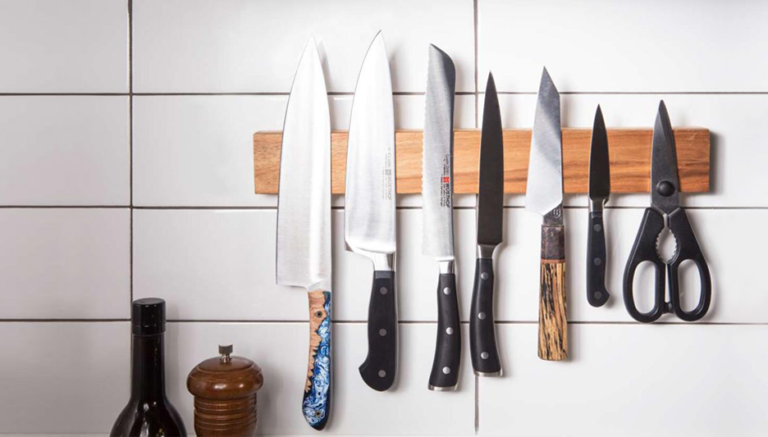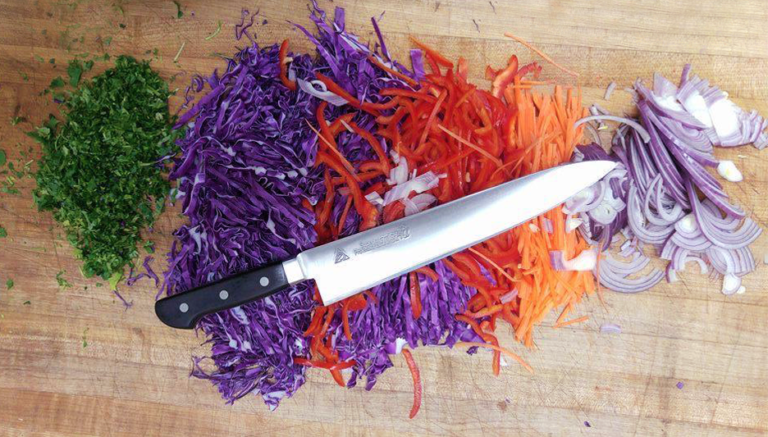Have a question?
Frequently
Asked Questions
Professional Knife Sharpening
Everyone who works with knives knows the value of a good sharp edge. I know how important your tools are to you and have put a lot of research and thought into the type of sharpening system I use. My goal is to provide you with the sharpest edge available while protecting your knives.
Each sharpening begins with an exam of the knife under magnification. This tells me about how the knife has been used, sharpened and what it needs to bring it back to optimal sharpness for that individual knife. It will tell me what angle to sharpen at, and at times, even tells me where the knife was last sharpened. If there are nicks or a broken tip, I will usually consult with the owner. These can be fixed, but at the expense of metal, thereby shortening the life of the knife. Sometimes they will not impact the knife’s sharpening capability and the owner may opt to just leave them alone while sharpening the rest of the blade.
Most professional knife sharpening is done on machines of some sort. I use the highly rated Edgemasters sharpening system which uses a series of rotating sanding belts of very fine grit, instead of a grinder. Among sharpening professionals this is considered one of the best techniques. It protects your knife by pushing the metal down and forming a burr. The final stage of this type of sharpening is a leather strop. The leather stropping belt is charged with a fine honing compound which de-burrs and puts a mirror polished, razor edge on the knives. I am certain you will notice the difference in the sharpness of your knife.
Using your knife correctly will give you many years of service with good performance. Do not push straight down on your knife, it is hard on the edge and can result in arm fatigue for you. When you cut, move the blade in either a forward or backward direction (picture a “locomotive” motion.) By pushing the blade forward when you chop, rather than pushing straight down, the blade does the work instead of having to use your muscle to cut. This applies to pulling back on the knife as well. This motion will cut down on strain and keep your edge in good shape.
It is important to store your knives in a block, a case, on a magnetic bar, or back in its original box. In a drawer loose, they can get dulled or chipped.
Your cutting surface is key to keeping your edge sharp. We recommend wood, and polypropylene, all of which are softer materials and will “give” under the blade. If the knife can leave a cut line in the board, your cutting board is sufficiently soft. Never cut on hard surfaces, as this will dull your edges very quickly.
Honing will maintain your edge, but remember that there’s a big difference between honing and sharpening. The edge folds over with use, rendering even a sharp edge unable to cut well. Honing simply straightens the micro edge of your blade to give you the best performance possible—until your knife is ready for re-sharpening. I highly recommend the Messermiester 12″ ceramic rod with 1200 grit surface. Just a few light strokes on each side of your blade is all it takes.
Dishwashers can be hard on all your dishes, but it can be especially hard on knives because they tend to get knocked around during the cycle. Plus, when you wash different grades of metal together, brown spotting may occur on the higher quality metals. These spots can be difficult, if not impossible, to remove. Also, many dishwashing detergents contain corrosive agents which can also cause pitting or corrosion on your knives. You can protect your knives by hand washing your knives with gentle dish soap with no bleach or citrus extracts.
The best and easiest method is simply to wash the knife using a damp sponge and mild soap right after you use it. Make sure you do not run the sponge—or your hand—directly along the blade at any time! Thoroughly towel-dry the knife and let it air dry for a few minutes before returning to its proper storage. Never leave your knife sitting in a sink full of water. Not only can it be dangerous if you reach into the sink without seeing the knife; it can also be hard on any knife blade and handle if left soaking in water for an extended period of time.
Behind the Scenes
Watch Bob sharpen a knife and put its sharpness through the simple, yet reliable paper test.
How to Hone a Knife
Follow along with Bob as he demonstrates how to turn a dull knife into a sharp one with the help of a steel rod and proper honing techniques.
How to Hone a Knife
Follow along with Bob as he demonstrates how to turn a dull knife into a sharp one with the help of a steel rod and proper honing techniques.
How to Hone a Knife
Follow along with Bob as he demonstrates how to turn a dull knife into a sharp one with the help of a steel rod and proper honing techniques.
How to Handwash your knife
Learn how to properly and safely wash your sharp knife with Bob's short cleaning tutorial.
Knife Storage
A properly sharpened knife can make cutting a breeze! Make sure that you store it properly after every use.
Knife Storage
A properly sharpened knife can make cutting a breeze! Make sure that you store it properly after every use.


